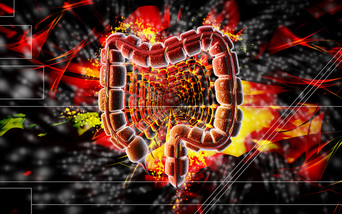What is the underlying cause of pyrrole? There are some who believe that Pyrrole disorder is not a real disorder but simply the manifestation of a toxic gut. I'd always understood pyrrole was genetic, once you had it, that was it, it was yours for keeps. It never really bothered me that others doubted the validity of its existence as a real disorder, after all, there is always someone saying something doesn't exist (the world is flat, global warming isn't real etc. etc. etc.) but when my son's pyrrole results came back clear after 2 years of treating a previous highly pyrrole result I got curious. Soon after I started to notice reports of pyrrole being cured on social media and I decided the issue may warrant further investigation. After reviewing the scant literature I don't think I have found an answer, but along the way of my research and reading I have discovered why there may be an increasing amount of people who seem to be 'getting' pyrrole disorder and the importance of managing oxidative and emotional stress. A pyrrole by any other name...If you look at it one way Pyrrole disorder is naught more than a name for excessive production of HPL (commonly referred to as 'pyrroles'). Stress of any kind will increase excretion of HPL. Excess is clinically marked by urinary levels greater than 20 ug/dl. Most people will have some level of HPL, a waste product of heme production, in their urine. Those with clinically elevated pyrroles will have a concurrent deficiency in zinc and vitamin B6. The bottom line is that everyone excretes some level of pyrrole in their urine and this level will elevate during times of stress. An unpublished (but much quoted) study on pyrrole elevation was a cold water immersion study by Tapan Audhya. In US Navy subjects he demonstrated that you could pop anyone in a pool of freezing cold water and watch their pyrrole count rise. Fortunately we don't suffer much from cold water immersion but we do often suffer from undue amounts of stress. Some claim that Pyrrole disorder is simply a disorder of oxidative stress. If pyrroluria itself cannot be proven to be caused by oxidative stress it certainly goes hand-in-hand with high levels of oxidative stress. However, we all suffer some degree of oxidative stress, is it simply a matter of degree? Pyrrole disorder is often found concurrent with metabolic issues. There is also a high prevalence in children with Autism, a condition often complicated with leaky gut, metabolic dysfunction and high levels of oxidative stress. I will explain more about oxidative stress below but for now a short crude description is that oxidative stress is the body rusting internally due the effect of too many toxins overwhelming the systems ability to detoxify. In the general population pyrrole disorder symptoms often appear following an acute or protracted period of emotional stress such as trauma or sudden loss of a loved one. The general idea is that the disorder lays dormant (as would concur with the epigetic theory) and the stress simply triggered it to manifest. The genetic predisposition to getting pyrrole disorder is often implicated with first order relatives having their own diagnoses, or a list of suspected 'other' illnesses in the family history such as anxiety, depression or even schizophrenia. Given there is little recent research on pyrrole disorder and no known genes related to the condition it is difficult to ascertain the true answer to this chicken and egg question. Two possible pathways for the genesis of pyrrole disorder
Woody McGinnis in his seminal paper "Discerning the Mauve Factor part 2" indicates that pyrrole disorder may have a large involvement with gut dysbiosis. Without going into the complicated citations he gives (you are welcome to read yourself, the link is below), McGinnis suggests that gut dybiosis is involved in the onset of pyrrole but it is triggered by significant emotional stress that marks the emergence of the disorder. "To explain the clinical observation that HPL excretion and stress are associated, Sohler specifically proposed that urinary excretion of HPL relates to a “stress-induced anomaly of intestinal permeability which permits these pyrroles to get into the systemic circulation.” It is well established that stress increases intestinal permeability. Psychosocial stress results in intestinal inflammation and greater intestinal permeability in humans. More specifically, emotional stress increases urinary excretion of compounds normally retained in the bowel." McGinnis et.al 2008  What McGinnis indicates here is that HPL may lurk in the gut (as a product of bacteria) and, given conditions of increased intestinal permeability (leaky gut), may spill over into the blood stream and urine. The involvement of psycho-soclal stress (read - emotional upset) creates the conditions for the gut to leak. How? Well thats a long story and the subject of another article but in brief it can be summerized that emotional stress at the physical level creates a lot of oxidative stress. For example; sudden loss of loved ones, trauma, relationship stress, constant emotional pressure and fear all release a flood of neuro-chemicals into the system. These chemicals increase oxidative load and can themselves shunt the bodily system into a state of oxidative stress. So what exactly is oxidative stress? Stress and Oxidative stressOxidation is the chemical process of removing electrons from an atom or molecule that is occuring within our cells moment to moment. It is an essential part of cellular metabolism but the culminative effect of this change can be destructive - rusting iron is a familiar result of oxidation. Oxidation is (amongst other things) the bodies way of detoxifying. Paradoxically, however, the oxidative process creates more toxic residue to be eliminated. These by-products include free radicals - electronically unstable atoms or molecules capable of stripping electrons from any other molecules they meet in an effort to achieve stability. Free radicals are like an unstable drunk at a party, bumping into other people and taking their drink. The bumped-into party-goer who just had their drink taken then turns to the person they knocked into and takes their drink, they then turn to the next person and take their drink and so it goes on until the party dies down, or, an anti-oxidant steps in to break the chain reaction. Putting this more technically, a each free radical steals from other molecules they in turn create even more unstable molecules that then attack their neighbours in domino-like chain reactions. Eventually this process fizzles out but in the mean time it may have ripped through vital components of cells causing extensive damage. Just like party goers at the end of the night and into the next day, the cells are now in a condition of stress and they will need time, rest, and lots of good nutrition in order to recover. But what if the party never ends? Cells create their own waste products as they go about their daily functions. In addition to our own inner garbage load we are constantly exposed to toxins from the air we breath to the processed food we eat creating more waste products to be processed and eliminated. Top this off with emotional stress - from deadlines and running late to relationship issues and past traumas and you can begin to understand why some cells (and the people they make up) never get the rest and recuperation they need. Oxidative stress goes hand in hand with inflammation. Emotional stress also cause inflammation. Emotional stress is a vastly underestimated additional tax on our bodies. Relationship stress alone can put you in a state of ongoing alarm sending a cascade of stress hormones and neuropeptides into your system. Anger and acute stress will make your digestive tract seize up. Work pressure and trying to do too much at once pushes adrenaline out and when it is ongoing the stress response is constantly turned on. If we all got a break every once and a while to really kick back and relax we might be okay. But we don't. We push on and on with coffee and smart phones in hand until then the next crises happens. Suffice to say here it is not all about clean living a lots of water and the odd trip to the gym. We never really allow time to completely detoxify and reset our system. Emotional stress can be the straw that breaks the camels back. Emotional stress can be the triggerIt is not hard to find people who's system's are already struggling to cope with the toxic demand of the environment and its own metabolic waste. Under these initially sub-optimal conditions the onslaught of a massive emotional trauma can throw the body into red alert, a state that is often not recovered from. This surge in stress adds to the oxidative stress overload, taxing the already taxed system. If these are the conditions for the gut to become leaky and pyrrole disorder to manifest, then why doesn't everyone who's way stressed have pyrrole disorder? Well, for one we don't know that more people don't have elevated pyrrole counts. Pyrrole is not routinely screened for anywhere so there could be millions of people walking around with elevated pyrrole who have no idea. Or, it could be that some people are more genetically vulnerable than others to the effects of stress and poor diet. Its certainly true that some people get more than their fair share of emotional stress and if this is coupled with childhood trauma or attachment difficulties then the person will be set up to experience more stress in the future. Add to this mix a rough lifestyle and lack of vitamins in the diet, plus a soil deficient in the vitamins we run low of and this could be enough to tip one into the danger zone. We are toxic, stressed and inflamed Oxidative stress is: Oh anti-oxidant, where for art thou? Our body's ability to detoxify and deal with excess free radicals is driven by anti-oxidants. As the name suggests anti-oxidants work against the oxidative effects by donating electrons that stop the domino effect of free radical damage in its tracks. Anti-Oxidants are the good-guys you want at your party. They will calm the free-radical's down by giving up their own drink in a cheery and charitable fashion. This will interrupt the crazy cycle of damage and start the clean up and repair process. The body make's its own anti-oxidants (Glutathione) but the body will also need fresh supply of anti-oxidants coming from food or supplements. Glutathione needs to be recycled and this process also requires incoming nutrients. Glutathione (GSH) is an intrinsic antioxidant that needs to be made and recycled within the body. GSH levels drop as we age at a rate of 10% a year after 20 years of age, on top of this a certain percentage of the population have pre-existing low levels of this important body cleanser due to the MTHFR and other genetic variants. GSH is the GSH requires selenium and zinc for adequate functioning - both of these nutrients are deficent in Australain soil and diets. NUTRIENT DEFICIENTCY COULD BE THE MISSING LINK The Link between MTHFR and pyrrole could be that the MTHFR 677t homozygous reduces methylation efficiency by 70% and dimishes the production/recylcling of GSH - low levels of GSH create high levels of oxidative stress Woody McGinnis states "Oxidative stress clearly results from deficiency of zinc or B6." The mechanism behind oxidative stress induced by zinc and B6 deficiency may be that these same nutrients are essential to the body's primary internally produced antioxidant agent - Glutathione (GSH). Inefficient detoxification can lead to heavy metal overload (another key suspect in the line up).
Can we simply blame the lack of zinc and selenium in the Australian soil interacting with genetic weakness to oxidative overload so we lack the very vitamins we need under times of extreme stress leaving us unable to recover from the visscitudes of life? Pyrrole disorder is a severe deficiency in Vitamin B6 and zinc. Pyrrole disorder is associated with high levels of oxidative stress. Oxidative stress is likely the result of low levels of nutrients essential to the maintenance of the body's endogengous antioxidant - GSH. Is the genetic tendency to a deficiency in the body's endogenous antioxidants But Which comes first, the deficiency or the oxidative overload? OR, are they the result of a 'perfect storm' created by toxic overload from the environment and poor diet, taxed detoxification, increasing nutrient deficiency (especially dietary antioxidants) and chronic and acute emotional stress coupled with and resulting in intestintal permeability. REFERENCES William J Walsh - Nutrient Power 2012 Fatty acids and oxidative stress in psychiatric disorders.Tsaluchidu S1, Cocchi M, Tonello L, Puri BK.(2008) http://www.ncbi.nlm.nih.gov/pubmed/18433515 Discerning the Mauve Factor Part 1 Woody R. McGinnis http://www.biobalance.org.au/_downloads/discerning-mauve-factor-part-1-galley-feb-2008.pdf Discerning the Mauve Factor Part 1 Woody R McGinnis http://www.biobalance.org.au/_downloads/discerning-the-mauve-factor-part-ii-galley.pdf The Effectiveness of Targeted Nutrient Therapy in Treatment of Mental Illness a pilot study Richard Stuckey, MB.BS., DRCOG; William Walsh, PhD; Brett Lambert ACNEM Journal 2010 Posts regarding integrative medicine, human behaviour, psychotherapy, gestalt therapy, bio-chemical disorders; pyrrole, methylation, copper and zinc imbalances, child behaviour, family relationships, parenting.
1 Comment
|
AuthorClarissa Mosley Categories
All
Archives
November 2022
|


 RSS Feed
RSS Feed



